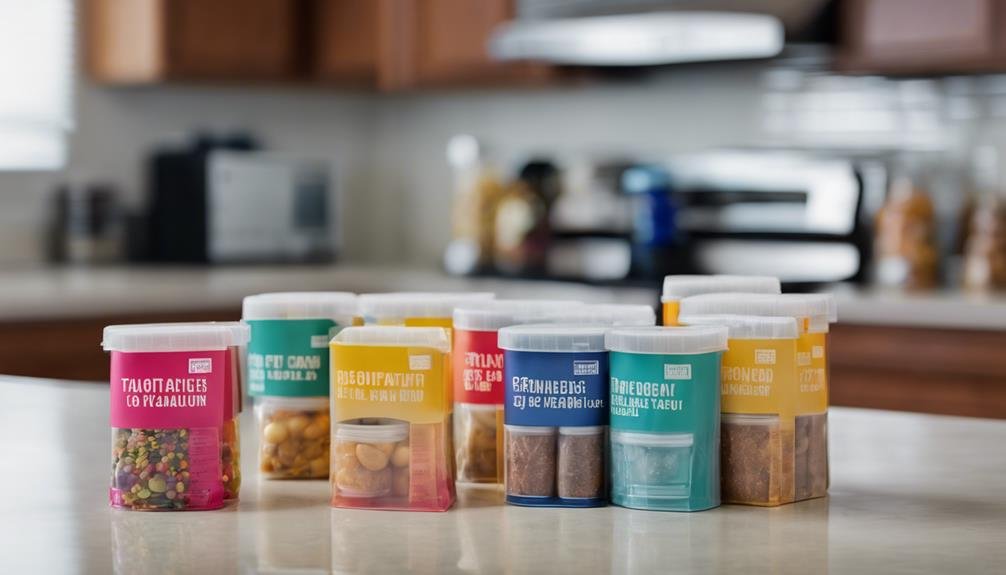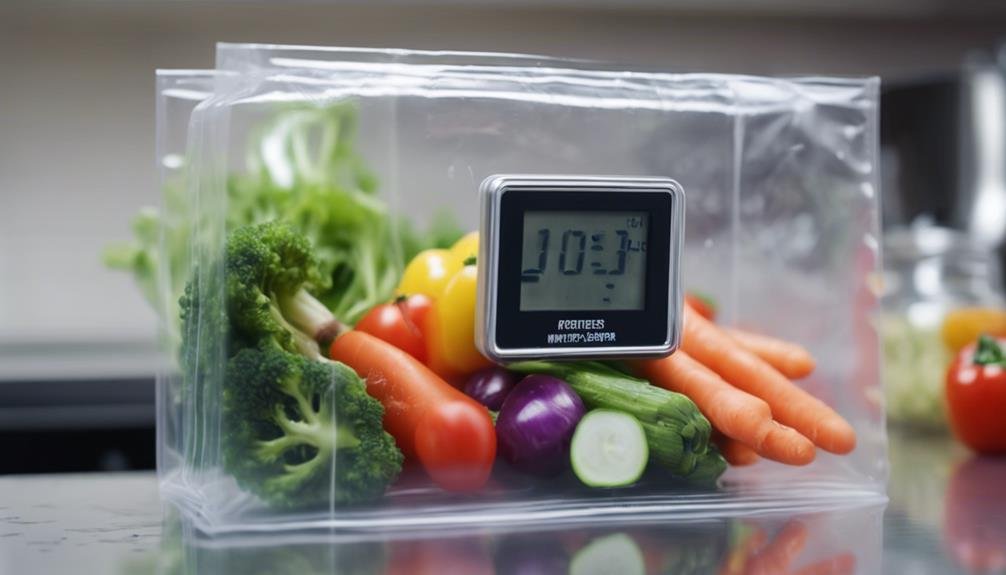To prevent contamination when vacuum sealing, start with a clean environment and sterilized equipment. Avoid cross-contamination by using separate bags for different foods and cleaning surfaces between items. Handle food safely, ensuring proper storage temperatures and labeling packages clearly. Choose durable, moisture-barrier packaging materials and seal foods in a clean area. Store sealed items in cool, dry places away from sunlight. Regularly inspect packages for leaks or signs of spoilage. When resealing, clean the area thoroughly and avoid raw items. By following these techniques, you'll greatly reduce the risk of contamination and extend your food's shelf life. Dive deeper to master the art of safe vacuum sealing.
Understanding Vacuum Sealing Basics
To grasp vacuum sealing, you'll need to understand its core principle: the removal of oxygen from packaging to create an environment that greatly slows food spoilage. This process, known as vacuum sealing, establishes an anaerobic environment that greatly extends the shelf life of various food products.
When you vacuum seal food, you're basically creating a hermetic seal similar to canning. This technique is particularly effective for preserving the freshness and quality of refrigerated, dried, and frozen foods. By eliminating oxygen, you're inhibiting the growth of bacteria and other microorganisms that cause food deterioration.
The meat industry widely adopts vacuum sealing, with an impressive 97% of beef in the USA being processed and transported using this method. This statistic underscores the technique's effectiveness in food preservation.
Understanding the basics of vacuum sealing is important for ensuring the safety and longevity of your stored foods. It's not just about removing air; it's about creating an environment that's inhospitable to spoilage agents. By mastering this technique, you'll be able to maintain food freshness for extended periods, reduce waste, and guarantee the safety of your stored products.
Cleaning Procedures Before Sealing
Proper cleaning procedures are essential before you start vacuum sealing to guarantee food safety and extend shelf life. To prevent contamination during the vacuum sealing process, you'll need to thoroughly clean all utensils, cutting boards, and surfaces. Use hot, soapy water to wash your hands frequently throughout the food sealing process, reducing the risk of spreading bacteria.
When handling food items, opt for clean spoons or tongs instead of your bare hands. This simple step can greatly minimize cross-contamination risks.
Don't forget to store your vacuum sealing materials in a clean, dry area, away from the floor, to avoid contact with potential contaminants.
To maintain a sanitary environment for food sealing, it's important to follow the manufacturer's instructions for cleaning and maintaining your vacuum sealer. Regular maintenance ensures that your equipment remains in top condition, further reducing contamination risks.
Proper Equipment Sterilization

Sterilizing your vacuum sealing equipment isn't just a vital practice—it's essential for guaranteeing food safety and extending shelf life. Proper sterilization eliminates harmful bacteria, pathogens, and microorganisms that can compromise the quality of your vacuum-sealed foods.
To maintain a hygienic environment, it's important to regularly clean and sanitize your vacuum sealing machine, tools, and surrounding surfaces. Use food-safe disinfectants and follow the manufacturer's guidelines for cleaning and sterilizing your equipment. This thorough approach helps prevent contamination and safeguards the safety of your preserved foods.
Implement a consistent sterilization routine before and after each use of your vacuum sealing machine. Pay special attention to any parts that come into direct contact with food, such as sealing bars and chambers.
Don't forget to clean and sanitize your work area, cutting boards, and utensils as well.
Avoiding Cross-Contamination
While vacuum sealing offers numerous benefits, it's important to be mindful of cross-contamination risks throughout the process. Vacuum sealing can help guarantee protection against cross-contamination by creating an airtight seal between different food items. This barrier keeps bacteria and pathogens from transferring between foods, enhancing overall food safety.
To maximize the effectiveness of vacuum sealing in preventing cross-contamination, follow these key steps:
- Use separate bags for different food types
- Clean and sanitize equipment between uses
- Label packages with contents and date
Handling Food Safely

Safe food handling is essential when you're vacuum sealing to guarantee the best quality and longevity of your stored items. As you prepare for vacuum sealing, it's important to follow essential safety guidelines to prevent contamination and maintain the food's safety for consumption.
Start by maintaining a clean environment. Keep your utensils, cutting boards, and counters spotless to avoid introducing harmful bacteria during the food handling process. Always wash your hands thoroughly before and during vacuum sealing to maintain cleanliness. When handling food, use clean spoons or tongs instead of your bare hands to minimize the risk of contamination.
To prevent cross-contamination, store different types of food separately when vacuum sealing. This practice helps maintain the integrity of each item and reduces the risk of spoilage.
Don't forget to label your vacuum-sealed packages with the type of food and packaging date. This simple step aids in proper rotation and ensures you use the oldest items first.
Choosing the Right Packaging Materials
Selecting the appropriate packaging materials is essential for successful vacuum sealing and long-term food preservation. When choosing packaging for your vacuum sealing needs, opt for vacuum sealing bags or rolls specifically designed for food storage. These materials are typically made from high-quality, BPA-free plastics that are FDA approved for food contact, ensuring the safety and freshness of your stored items.
Look for vacuum sealing bags with multiple layers, as they provide a superior moisture barrier and protect against air and odors. Some bags even come with built-in oxygen absorbers, further extending the shelf life of your food products. Durability is also vital, so select puncture-resistant materials that can withstand the vacuum sealing process without leaking.
To maximize the benefits of vacuum sealing, consider the following:
- Choose bags with textured inner surfaces to enhance air removal
- Opt for reusable bags to reduce waste and save money
- Select different sizes to accommodate various food items
Labeling and Dating Sealed Foods

Proper labeling and dating of your vacuum-sealed foods is essential for maintaining an organized and efficient food storage system. When you vacuum seal items, it's important to label each package with the type of food and the date it was sealed. This simple step helps you track freshness and prevents confusion about what's inside each package.
By including clear labels, you'll easily identify contents without having to open sealed bags. This practice allows you to prioritize consumption based on packaging dates, ensuring you use older items first.
Don't forget to add expiration dates to your labels, as this promotes food safety and helps you avoid consuming spoiled items.
Dating your vacuum-sealed foods also enables effective rotation of stored items. You'll reduce waste and maintain optimal freshness by using older packages before newer ones.
Clear labeling optimizes your storage space by allowing you to organize foods more effectively, minimizing mix-ups and making it easier to find what you need.
Optimal Storage Conditions
Now that you've labeled your vacuum-sealed foods, you'll want to store them in the best possible conditions to maximize their shelf life and quality. Best storage conditions for vacuum-sealed food typically involve refrigeration or freezing. These low temperatures help maintain freshness and prevent bacterial growth, which is already inhibited by the airtight environment created through vacuum sealing.
To guarantee the best storage conditions for your vacuum-sealed food, follow these guidelines:
- Choose a clean, dry, and cool environment for storage
- Refrigerate or freeze items whenever possible
- Keep packages away from direct sunlight and heat sources
By adhering to these top storage conditions, you'll greatly reduce the risk of contamination and spoilage. The vacuum sealing process protects your food from external contaminants, but proper storage is critical to maintaining this protection over time.
Remember that while vacuum sealing extends shelf life, it doesn't make food last indefinitely. Regularly check your stored items and consume them within a reasonable timeframe.
Monitoring Sealed Food Quality

Even with high-quality vacuum sealing and storage, you'll need to stay vigilant about monitoring your sealed food's quality to guarantee its safety and freshness over time. Regular checks are important to make sure your vacuum sealing efforts aren't in vain.
Start by visually inspecting your sealed food for any signs of spoilage or discoloration. These can be indicators that the food's quality has deteriorated despite being sealed.
Don't forget to examine the vacuum-sealed bags themselves for any leaks or punctures that could compromise the food's integrity.
Using a food thermometer is essential to confirm that your sealed food is stored at safe temperatures. This step is particularly important for perishable items that require specific temperature ranges to maintain their quality.
To stay organized, maintain a detailed inventory of your vacuum-sealed items. This will help you track freshness and consumption dates, preventing accidental use of expired foods.
Implement a rotation system to make sure you're using your vacuum-sealed foods in a timely manner, reducing waste and maximizing your investment in vacuum sealing technology.
Best Practices for Resealing
When it comes to resealing vacuum-sealed bags, you'll need to follow specific practices to maintain food safety and extend storage life. Proper resealing techniques are important to prevent the introduction of contaminants and ensure the freshness of your stored items.
To avoid cross-contamination, it's vital to never reseal bags that previously held raw meat or fish. Instead, use new bags for these items. If you're resealing bags with non-food items, thoroughly wash and dry them first to eliminate any potential contaminants.
Here are three key steps to follow when resealing vacuum-sealed bags:
- Clean the sealing area: Ensure the bag's opening is free from moisture, food particles, or debris.
- Follow manufacturer guidelines: Each vacuum sealer may have specific instructions for best resealing.
- Inspect the seal: After resealing, check for any gaps or imperfections that could compromise the bag's integrity.
Pac Food's introduction of recyclable vacuum bags offers a sustainable option for those who frequently reseal items. By adhering to these best practices, you'll maintain the safety and quality of your vacuum-sealed goods while minimizing waste.
Conclusion
You've now mastered the art of vacuum sealing to prevent contamination. Remember, cleanliness is next to godliness, so keep your equipment spotless.
Always handle food with care, label meticulously, and store properly. Monitor your sealed goods like a hawk watches its prey.
By following these best practices, you'll guarantee your victuals remain as fresh as the day they were sealed, preserving them as if they were in King Tut's tomb.
Keep sealing smartly!
